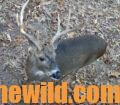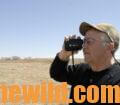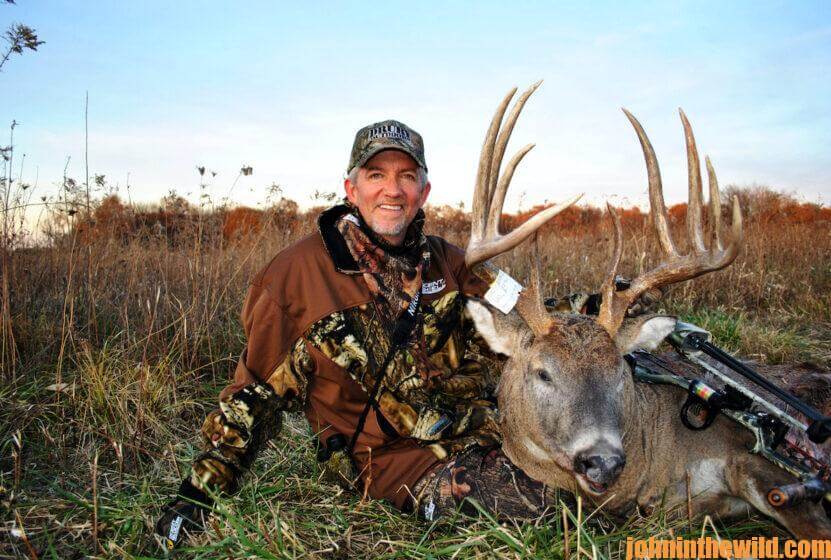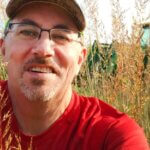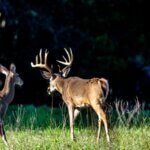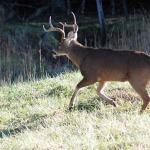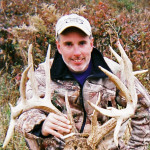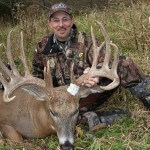Editor’s Note: Many states are now in their postrut times of deer season. Terry Drury of Drury Outdoors https://www.druryoutdoors.com/, along with his brother, Mark, are two of the most well-known and most-recognized deer hunters in the nation, due to their TV shows, videos and podcasts. One of the questions they’re often asked is, “How do you take a buck after the rut?” This week Terry will tell us how to hunt after the rut.
 Another postrut buck I took one year was on my farm in Missouri. My son Matt Drury had seen this buck during firearm season, and my grandson Carter had had an encounter with this same buck. But neither Matt nor Carter had had the opportunity to take a shot at the buck. We had named this buck the “Big Sissy,” because he always fed just on the edge of the field. He never would walk out into the field where another buck might be. Even though I never had seen this buck in person, I could tell he was a sissy, because of the video footage we got of this deer. I could tell by his body posture that he wasn’t looking for nor would he participate in a buck fight. He didn’t have a very-aggressive personality. I’m almost certain this buck was a 4-1/2-year-old buck. I first began to notice him when he was a 3-1/2-year-old buck. I hunted him as a postrut buck in December.
Another postrut buck I took one year was on my farm in Missouri. My son Matt Drury had seen this buck during firearm season, and my grandson Carter had had an encounter with this same buck. But neither Matt nor Carter had had the opportunity to take a shot at the buck. We had named this buck the “Big Sissy,” because he always fed just on the edge of the field. He never would walk out into the field where another buck might be. Even though I never had seen this buck in person, I could tell he was a sissy, because of the video footage we got of this deer. I could tell by his body posture that he wasn’t looking for nor would he participate in a buck fight. He didn’t have a very-aggressive personality. I’m almost certain this buck was a 4-1/2-year-old buck. I first began to notice him when he was a 3-1/2-year-old buck. I hunted him as a postrut buck in December.
I’m almost certain the reason this buck came out and presented the shot is where we were hunting with cold temperatures and a full moon. We had a north by northwest wind, a bluebird day and a rising barometer about 30.28. All the conditions were right for bucks to be on the green fields.
Once again, here are some important ingredients for taking postrut bucks, having:
- a falling temperature;
- a full moon;
- little or no hunting pressure on the area where you’re going to hunt; and
- a good food source.
I took this buck on a BioLogic http://www.plantbiologic.com/ field I had planted with BioLogic Maximum, Winter Bulbs and Sugar Beets and Deer-Radishes. I like to mix several different types of Mossy Oak BioLogic products in my fields. Then the deer have a variety of food on which they can feed. The buck was coming from the BioLogic field into a standing cornfield I had planted. The standing corn was about 10 to 12 feet high, and it provided security cover for the buck. The BioLogic was only about one foot high. It provided the food for the buck. I liked the height difference between the standing corn and the BioLogic field. The deer had plenty of highly-nutritious food to feed on in the BioLogic field, and the standing corn provided cover and food. I believed that by designing your green fields where you had two food sources – one that provided food and cover, and the other food source that provided a variety of foods that the deer could eat, you drastically could increase the number of deer you saw after the rut, if your hunting area had falling temperatures and a full or a partially-full moon.
I also created a scrape tree and put it out in front of my box blind. I cut down a shingle oak, used a post hole digger to dig a hole to put the trunk of that tree in and set it within easy range of the box blind. Mark and I both liked to create inside and outside corners. The inside corner was where the BioLogic field and the cornfield meet. The outside corners were where the BioLogic field met the woods, and the cornfield met the woods.
We saw tremendous deer movement that afternoon. We had 35 deer on the BioLogic field at one time. The Big Sissy was the fourth buck on the field that was on our hit list to harvest that season. We observed that the deer would come out and feed there. Then they would walk into the standing corn.
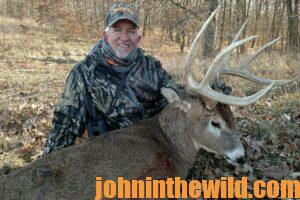 I tried to take an 11 pointer that would score 150 to 160 inches, before I took the Big Sissy, but I couldn’t get the window on my box blind opened quickly enough before the 11 pointer vanished into the standing corn. After the Big Sissy had fed in the BioLogic field for about10 minutes, he walked right in front of the blind at 30 yards and headed into the standing corn. I grunted to him, stopped him and took the shot with my crossbow. I’d never been known to shoot a crossbow, but not because I didn’t like them. I just preferred to shoot a compound bow. However, remember, I told you I fell out of my tree stand. My ribs were sore, and I couldn’t pull my compound bow. I hadn’t been healing a full four weeks yet, but I was determined to hunt this season, and I was determined to hunt with a bow. So, this crossbow was the natural choice.
I tried to take an 11 pointer that would score 150 to 160 inches, before I took the Big Sissy, but I couldn’t get the window on my box blind opened quickly enough before the 11 pointer vanished into the standing corn. After the Big Sissy had fed in the BioLogic field for about10 minutes, he walked right in front of the blind at 30 yards and headed into the standing corn. I grunted to him, stopped him and took the shot with my crossbow. I’d never been known to shoot a crossbow, but not because I didn’t like them. I just preferred to shoot a compound bow. However, remember, I told you I fell out of my tree stand. My ribs were sore, and I couldn’t pull my compound bow. I hadn’t been healing a full four weeks yet, but I was determined to hunt this season, and I was determined to hunt with a bow. So, this crossbow was the natural choice.
I shot that crossbow for six hours before I actually hunted with it. I tried different lengths of bolts and various types of helical fletchings. I probably shot 12-different bolts to try and choose the bolt that would give me the tightest group. All of the bolts I tested shot extremely well when I was shooting field tips. But when I screwed a Rage practice tip ( https://www.feradyne.com/search.php?search_query=practice%20tips§ion=product) into the ends of the bolts, I could tell a huge difference in the way the bolts flew. The bolts that shot the best were the ones that had a slight helical to the fletchings.
When I ranged the Big Sissy buck with my range finder, I determined he was at 30 yards. I squeezed the trigger, and the broadhead hit a little high and forward of where I was aiming. I can’t blame the bolt, the broadhead or the crossbow. I just didn’t make as accurate a shot as I would have made if my ribs hadn’t been hurting. When I realized I’d hit the deer high, I was extremely concerned, because we have an old saying when deer hunting, “Hit ‘em high, and wave goodbye.” When the buck ran off, his tail was up instead of down, like it would be when I’ve made a good hit.
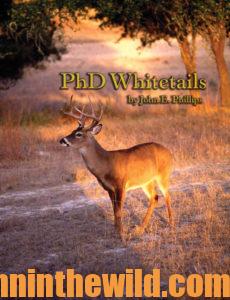 After we reviewed the footage that my cameraman had been taking, I saw that the bolt in the broadhead had penetrated about 12 or 14 inches into the deer. I knew that buck was double lunged then, and I actually thought I had heard the buck fall. However, I thought he was gone forever. But then when I looked at the video footage, I knew I had a good hit. That is one of the reasons that I strongly believe in videoing your hunt, because you can see where you’ve hit the deer immediately after the shot. When I saw that I had a good hit, we immediately went to track the buck. The buck had only gone about 65 yards from where he had taken the arrow.
After we reviewed the footage that my cameraman had been taking, I saw that the bolt in the broadhead had penetrated about 12 or 14 inches into the deer. I knew that buck was double lunged then, and I actually thought I had heard the buck fall. However, I thought he was gone forever. But then when I looked at the video footage, I knew I had a good hit. That is one of the reasons that I strongly believe in videoing your hunt, because you can see where you’ve hit the deer immediately after the shot. When I saw that I had a good hit, we immediately went to track the buck. The buck had only gone about 65 yards from where he had taken the arrow.
 To learn more about hunting for deer, check out John E. Phillips’ deer-hunting book, “PhD Whitetails: How to Hunt and Take the Smartest Deer on Any Property,” available in Kindle and print at http://amzn.to/WIEUoo and Audible at https://www.audible.com/pd/PhD-Whitetails-Audiobook/B08VYMWS6J. You may have to copy and paste this link into your browser. (When you click on this book, notice on the left where Amazon says you can read 10% of the book for free). On the right side of the page and below the offer for a free Audible trial, you can click on Buy the Audible book. To see more of John’s deer-hunting books, visit www.amazon.com/author/johnephillips. John and Denise Phillips’ new book, “The Recipes You Can’t Live Without,” that’s full of delicious, time-tested recipes for cooking wild game and fish and also ideas for breakfasts at your hunting club just was published in print this month. Go to https://www.amazon.com/dp/B09MYTMSMH?ref_=pe_3052080_397514860 to learn more.
To learn more about hunting for deer, check out John E. Phillips’ deer-hunting book, “PhD Whitetails: How to Hunt and Take the Smartest Deer on Any Property,” available in Kindle and print at http://amzn.to/WIEUoo and Audible at https://www.audible.com/pd/PhD-Whitetails-Audiobook/B08VYMWS6J. You may have to copy and paste this link into your browser. (When you click on this book, notice on the left where Amazon says you can read 10% of the book for free). On the right side of the page and below the offer for a free Audible trial, you can click on Buy the Audible book. To see more of John’s deer-hunting books, visit www.amazon.com/author/johnephillips. John and Denise Phillips’ new book, “The Recipes You Can’t Live Without,” that’s full of delicious, time-tested recipes for cooking wild game and fish and also ideas for breakfasts at your hunting club just was published in print this month. Go to https://www.amazon.com/dp/B09MYTMSMH?ref_=pe_3052080_397514860 to learn more.
Tomorrow: How to Take a Postrut Buck

